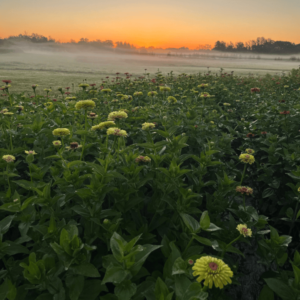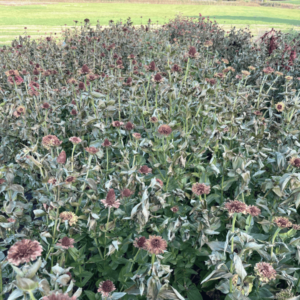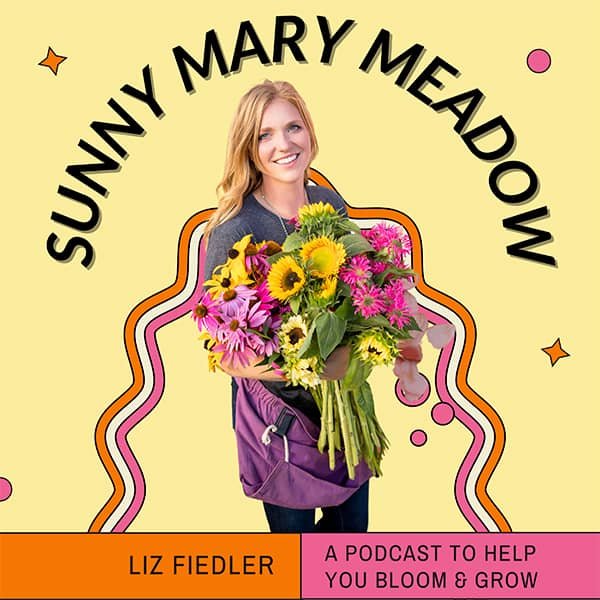
In one of our recent episodes/blog posts, we talked about six different flowers you can start if you are brand new to growing a cut flower garden. These are seeds that are direct-seeded, which means you plot the seed directly in the ground, cover it with dirt, and water it occasionally. These were all flowers you waited to plant until after your last frost. In this episode/blog post, I wanted to tailor it to someone who’s already done that. I don’t want to say that you must be experienced to listen to this episode or read this post because you definitely don’t have to be, but it will get a LITTLE bit more complicated. Not too much, I promise, because I want this to apply to everyone, but I am going to bring it back to season two of growing for me.
Remember, I’m in my fourth season, so if I talked about what I am growing now, I think that would get complicated, and I think we need to get into that a little bit later. I have such specific needs regarding when my subscriptions are and when my “you-picks” are scheduled, and it gets a little complicated. I actually grow a lot less variety than I used to, and I focus more on succession planting and ensuring they bloom at different times.
So, I just want to bring us back to season two – I already had one successful year, sold about 200 bouquets, and did nursing home bouquets. I had a big enough garden for about 400 bouquets that summer (2020). Now we’ll get into 2021 and how I decided what to grow. I tripled my growing space – the sky was kind of the limit, but you can’t grow everything.
How Long Is Your Growing Season?

The first thing you need to do is figure out what your season looks like regarding the weather, the temp, and how long you have to grow. There are two terms that you’ll come across frequently when you’re reading, and it’s important to know the difference. There are “zones,” and there is “your last frost date.” Your USDA Hardiness Zone is more so for perennials – you’re going to look at a map and see what is hardy within your Zone. For example, some plants are perennials that come back year after year, but it will say hardy to Zone 6 or hardy to Zone 3 (that means it pretty much comes back year after year anywhere). If you live below Zone 6, they will die in the winter where you live.
I’m in Zone 4, and it is divided into 4a and 4b because it gets SO cold up here. And then, for the last frost date, you want to type in your ZIP Code because it will be different everywhere, and it depends on where you are in relation to things like a lake, elevation, etc. It doesn’t necessarily matter how far north or south you are because it’s a lot more elevation-based. There are places in Arizona with the last frost date of June 1st, so when planting zinnias, you literally have to wait until you’re in the clear (on average) of being above 32° degrees.
Now, there are things you can do, like cover it with frost cloth or use an overhead sprinkler, and I did that one year, but this is all going to be its own podcast/blog post, specifically talking about what to do if there’s an emergency frost coming. Essentially, for me and where I’m located, I’ve got from about May 15th to September 20th for heat-loving annuals like sunflowers, zinnias, cosmos, and many herbs (like basil). So really, I’ve got about 125 days – I need to really look at what will grow here and what will thrive.\

Where Are You Going to Purchase From?
I’m going to give you the recommendation of a website (and I am in no way sponsored by them – I wish, so if anyone from Johnny’s Seeds is listening or reading this, you can email me and reach out to sponsor me). Johnny’s Seeds are great – go on their website, go into “flowers,” and then you can filter specifically to “cut flowers.” You want to filter to things that will do well in a vase and cut flowers. And so now that you know your last frost date, perennials, and growing season, you need to look at the growing information when you decide what to plant.
If it is something that says, “days to maturity,” really focus on that – are you going to plant them up early? Direct seed them? Are you going to start them in trays? Often, it’ll give a recommendation – “transplant not recommended” because they’re a deep root, and they don’t transplant very well. So, then you have to hope that either they’re a cold hardy annual, and it’ll say on there that you can plant them as soon as the ground can be worked, or you have to wait until after the last frost.

How Soon Do the Seeds Need to be Planted?
If it says as soon as the ground can be worked – Nigella is an example of that (or bupleurum, or orlaya). Last year, I planted them around April 15th, which was pretty early (and they even got some snow on them), but they did great. So, I directly seeded them in the ground and planted them then. Otherwise, if they say, “after last frost” or “direct-seed recommended,” like sunflowers, for example, then you have to wait until after May 15th. So, when you’re trying to decide what to grow, if it is April 1st and you’re finally buying seeds, you’re not going to want to buy something that says, “we recommend you sow them in a seed tray 10 or 12 weeks before your last frost”, because you should have started them from seeds in February. I go by that and decide, “What is my goal here? Do I want to start a lot of them in trays? Do I want to direct-seed a lot of them? Is it okay if I don’t have flowers until July?” and then decide what you want to grow and what you want to buy.

What’s Your Budget?
You definitely need to keep your budget in mind because it is so easy to go overboard. I recommend finding a friend to split some seeds with because the shipping can be astronomical on some of these websites, and the more you buy in bulk, the cheaper it will be. Usually, a packet of 50 seeds, by the time you get them to germinate, ends up being not as many as you think it’s going to be. However, keep in mind that these tiny little seeds make a plant, and if you’re hoping for one bouquet week for yourself, or maybe a couple of bouquets a week, you really only need eight Zinnia plants. You don’t need 300 of them in one color as I have. So, when you’re trying to figure out the quantity to order, just keep in mind – look at the germination rate on the seed packet and then decide how you want to go from there.
What Colors Should You Buy?
You can buy seeds in a couple of different ways, and they usually come in a mix of specific colors. Where I’m at now, for how I’m growing them and using them all for bouquets and sell them or having stem bars where I have 5-gallon buckets of flowers, I do not have time to sort by color after I pick them. I need a row of light pink, a row of white, a row of purple, and a row of salmon. Honestly, for the mix packets, the reason they’re cheap is that they’re the leftovers. It’s just a mystery mix of Benary‘s Giant Zinnias. It will have some red, some yellow, some white … and it usually ends up patterned enough that you might have a couple of colors next to each other. But, for the most part, it’ll be spaced out pretty evenly and look really pretty in the garden.
If you’re trying to make bouquets out of specific colors, and sort them by the bucket, do not buy the mixed packets. It just takes way too much time to sort them, and honestly, they’re going to be the bright colors that the majority of your customers aren’t going to want. They’re not the trendy colors – they’re more like pumpkin/jack-o’-lantern orange … and I think they look cool, and my daughter loves them, and they’re fun … but for what I do, they don’t really work as well anymore. Honestly – buy what you like.

When Should You Order?
The other thing you want to remember is when to order. For example, with tulip bulbs, I ordered over 10,000 tulips in May because that’s when I knew I would get the best variety. As a general rule, when you’re harvesting is about the time that you order again. So, Ranunculus, you want to order in June. For seeds, most cut flower farmers have their seeds ordered for next year for sure by mid-October. So, keep those notes, have a running list of what you like, and as a general rule (this is going to be a really hot topic/can be an unpopular opinion), keep in mind you really do need the focals, the foliage, and the fillers. I know some growers are like, “I quit growing any fillers. I don’t need any greens. Nobody picks them at you-picks,” and it just depends on how you do it.

What Types of Flowers Should You Grow?
Some flower farmers I follow on social media only grow main focal flowers. There is one that’s really successful in Michigan that comes to mind. She has lines out the driveway to her farmstand, has over 100,000 followers on Instagram, and it’s become this destination place. She doesn’t sell a lot of green fillers because she basically charges by the stem. This is totally fine if that’s how she does her model – I think it’s 12 to 15, or 10 to 12 stems, for $25. Well, if I only get 10 to 12 stems and you’re out there picking, I will pick as many pretty flowers as I can, and I won’t get the green leaves because I want more bang for my buck.
At this point, for my YouPicks, I’m not 100% sure how I will charge for mine. I think I will charge a little bit more, have a 32-ounce cup, and say, “fill it up; really, there are no restrictions.” I’m just not going to put any plants down there that I don’t want people touching, which is kind of my rule of thumb. I hate making rules for a good time, but I am a planner. I like rules and policies, but I am also self-aware enough to know that most people aren’t like me. So, my dahlias, my eucalyptus, and my lisianthus will not be in the you-pick section. They are too valuable and can be damaged if cut incorrectly, so they are going to be across the yard by my high tunnel, and my hope is that I can have some of those for sale à la carte if you want some extra dahlias… or maybe it’ll include one of each of those or something. But otherwise, it’s “here’s your big 32 oz paper cup, and if you want to put 15 zinnias in there, you go for it.” If you can fill it in your cup, then you’ll definitely want those whimsical fillers that are airier like the statice or the cosmos, and not just the focal flowers – the sunflowers, the big zinnias, those things are more eye-catching, and then you’re going to need some of the greens in there to fill it out so that it looks bigger and fuller.

When you’re ordering your seeds, keep that in mind – if you have just snapdragons and zinnias, you’ll need many of those premium cuts to make it look full. There are many reasons we have fillers and foliage because otherwise, if I sell them by the stem and have just those premium stems, it won’t work out the greatest. Just make sure when you’re ordering your seeds, you have a combination of all of that.
What the Heck Are Plugs?
I’m going to do an entire episode on plugs, but I want to give you a little just a little vocab lesson on what that is because I’m going to be referencing it a lot. And until I’m ready to do a whole podcast episode on that one, I think it might get confusing. Plugs come in a tray of either 125 or 210. I ordered them last fall, they are made-to-order from the company that I go through, and they know exactly what week they need to start them so that they are ready to plant when I receive them. I will receive some on May 8th – they will arrive here ready to plant. Depending on where the frost is, I might need to keep them alive in the tray for another week or two. Remember my last frost is around May 15th. If there is no low-temperature forecast below 40 degrees in the next ten days, and it’s May 10th, I will plant them. But if it looks like the low-30s, I will hold off and wait, depending on what they are (some varieties are cold-hardy and can survive a light frost). But basically, I ordered plugs for anything that needed to be started in seed trays more than six weeks out.
If I were seeding them all myself (as I did in seasons 1-3), by April 1st, I could have a whole rack of seed trays. I have not decided that if it takes longer than that, and I have to keep it alive in a tiny little seed tray or soil block, that’s honestly too much babying. I did the math, and I figured out what my time is worth, and it’s just not worth it for me, mainly because I don’t enjoy that part. Even if it’s 15 minutes in the morning and 15 minutes at night (adjusting the lights up and down; otherwise, they get really leggy or skinny because they’re reaching for the light, you can dry them out really easily, you can overwater them really easily and they get moldy, and then the germination rate is poor, etc.) it takes away time that is pretty precious to me. In the morning, I have to get the kids up and ready, out the door to daycare and school by 7:00 A.M., etc. When the plugs arrive, they’re lush, all alive, sorted by color, and exactly how I wanted. I ordered eucalyptus, snapdragons, stock, and lisianthus – things that take 12-16 weeks to grow, and it’s just perfect. I’ll still start a ton of seeds, but not until early April. I think it will also make the growing season more manageable, and I won’t get burned out so quickly.
I will do an entire episode/blog post on seed starting, and I have a couple of guests in mind. We’re going to discuss starting in trays versus something called soil blocking, and it’s kind of like a big sports rivalry in the gardening world. I’ve personally never done soil blocking – I don’t think it’s up my alley – but I think the discussion will be very interesting.

Are These Going to Bloom in Time for Me to Actually Enjoy Them?
I look and decide what I can actually grow in my time frame. For example, if it says it needs to be direct-seeded after the last frost and days to maturity is 120 days, I’m just not going to grow it. It won’t pay off for me because it will just start blooming right as frost kills it. Or, if it says you need to start it this many weeks before the last frost and transplant it, and it can’t handle a frost (basically anything that’s going to bloom in early September), it probably isn’t going to work in my zone/my area. When you want to grow something, think about when it will bloom and if you can actually enjoy it.
Another example is sunflowers; the variety I plant is 50-60 days to maturity (the ProCuts). If I want to order this quantity, they’re done blooming and harvested early-to-mid July if I plant them all immediately. I will, therefore, want to use succession planting (which we’ll discuss in a future episode/post). I wait a little bit longer to plant them, or maybe I’ll do one whole row of this color, and then I’ll wait until they’re done, and I can actually plant them up until mid-July. So, when I’m looking at the quantity to order, I keep that in mind – I can do more of those because I can actually get multiple blooms out of the same spot.

How Can I Save Some Money on This Hobby?
A really fun practice to get into is splitting seed packets with your friends and having a seed swap (seed-saving is something we will talk about in another episode/post – it’s where you can save your own seeds). Ultimately, when adding the seeds to your cart, ensure you have a good variety. I would stay away from the mixes and make sure you’re buying what you like.

Questions from Abbey
Abbey: If you’re someone like me who is a novice and on a whim decides I’m going to do flowers this year, on a smaller scale, but I’m going to do it! And let’s say it’s today’s date in early February, what would you recommend I start with? Which should I focus on? Should I focus on some of the bigger things, like sunflowers?
Liz: I actually addressed this very topic in our previous episode, where I named the six things I would start with if I were just getting started growing my very first cut flower garden. It can be a brand-new beginner gardener or someone that has previously grown a vegetable garden but wants to dabble in flowers.
Another tip is if you go to a greenhouse and buy a 4-pack or 6-pack of some annual flowers, you can transplant those if they’re an appropriate cut flower. Often, the white tag will say right on it, “cut flower.” Keep in mind, however, many of those greenhouse varieties are genetically modified as a dwarf variety because they need to look good in pots. So, the zinnias you buy at a greenhouse to put in a small pot differ from the seeds I’m talking about. Those stems will be 6” long compared to the ones I plant that end up 36” long.
If you like what you’re hearing, please subscribe and rate us. You can also find us on Instagram, Pinterest, and Facebook.
You can subscribe to our email newsletter below. We love to hear any podcast-related feedback at our email podcast@sunnymarymeadow.com, and all other inquiries can be sent to liz@sunnymarymeadow.com.

